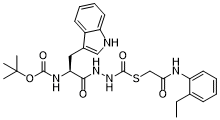| Cas No.: | 958772-66-2 |
| Chemical Name: | SID 26681509 |
| Synonyms: | S-{2-[(2-Ethylphenyl)amino]-2-oxoethyl} 2-[(2S)-3-(1H-indol-3-yl) -2-({[(2-methyl-2-propanyl)oxy]carbonyl}amino)propanoyl]hydrazine carbothioate (non-preferred name);SID 26681509;N-[(1,1-Dimethylethoxy)carbonyl]-L-tryptophan 2-[[[2-[(2-ethylphenyl)amino]-2-oxoethyl]thio]carbonyl]hydrazide (ACI);L |
| SMILES: | C(C1=CNC2C=CC=CC1=2)[C@H](NC(=O)OC(C)(C)C)C(=O)NNC(=O)SCC(=O)NC1C=CC=CC=1CC |
| Formula: | C27H33N5O5S |
| M.Wt: | 539.646425008774 |
| Purity: | >98% |
| Sotrage: | 2 years -20°C Powder, 2 weeks 4°C in DMSO, 6 months -80°C in DMSO |
| Description: | SID 26681509 is a potent, reversible, competitive, and selective inhibitor of human cathepsin L with an IC50 of 56 nM. SID 26681509 inhibits in vitro propagation of malaria parasite Plasmodium falciparum and inhibits Leishmania major with IC50s of 15.4 μM and 12.5 μM, respectively. SID 26681509 shows no inhibitory activity against cathepsin G[1]. |
| Target: | IC50: 56 nM (Human cathepsin L), 15.4 μM (Plasmodium falciparum), 12.5 μM (Leishmania major)[1] |
| In Vivo: | SID 26681509 treatment significantly improves survival in murine models of sepsis and reduces liver damage following warm liver ischemia/reperfusion (I/R) models[2]. |
| In Vitro: | After a 4 hr preincubation with cathepsin L, SID 26681509 becomes more potent, demonstrating an IC50 of 1.0 nM. SID 26681509 is determined to be a slow-binding and slowly reversible competitive inhibitor. Through a transient kinetic analysis for single-step reversibility, inhibition rate constants are kon = 24,000 M-1s-1 and koff = 2.2 × 10-5 s-1 (Ki = 0.89 nM). Molecular docking studies are undertaken using the experimentally-derived X-ray crystal structure of papain/CLIK-148[1]. SID 26681509 inhibits papain and cathepsins B, K, S, and V with IC50 values determined after one hour ranging from 618 nM to 8.442 μM. SID 26681509 shows no inhibitory activity against the serine protease cathepsin G[1]. |
| References: | [2]. Pribis JP, et al. The HIV Protease Inhibitor Saquinavir Inhibits HMGB1-Driven Inflammation by Targeting the Interaction of Cathepsin V with TLR4/MyD88. Mol Med. 2015 Dec;21(1):749-757. |

 To enhance service speed and avoid tariff delays, we've opened a US warehouse. All US orders ship directly from our US facility.
To enhance service speed and avoid tariff delays, we've opened a US warehouse. All US orders ship directly from our US facility.




















